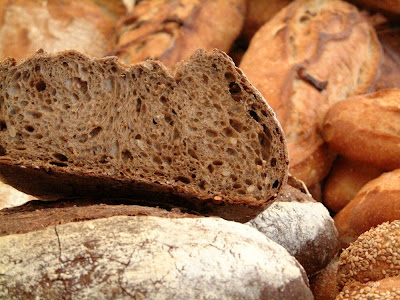
Sometimes when I think of my habits I have a gut feeling that a clinician may tell me much what I don’t yet know about myself.
Here is the case: I get a feeling of enormous gratification that borders on a sense of gigantic accomplishment when I finish my food leftovers. Every time I save a wilting, suicidal vegetable, I feel as if I save the planet. It can be former -Soviet neatnik in me, or dormant environmentalist, or just weirdo. I am not entirely sure about the cause, but the effect is strikingly friendly to the environment. In other words, I do not throw away food. And just so you know, the extent of my culinary thriftiness is such that I even eat apples whole, with seeds, core and all (except stem). (A handful years back I read somewhere that apple seeds contain iodine, of which almost everyone has a deficiency, said the source; that’s why my apple craze, perhaps?)
I was brought up with a belief that to throw away food that still can be turned into a delicious meal is, at the very mildest, irresponsible, and at the worst, a sin of sorts (this part seriously scared the bejesus out of me as a child, although it did not stop me from being overly picky at the time).
The source of culinary dogma in question was my maternal grandmother. As a teen, or even earlier, she had tasted the firsthand experience of devastating horrors of Second World War, in Russia and former Soviet republics known as Great Patriotic War (Eastern Front). My grandmother spent her late green years shuttling between train stations. Her task was to swap pieces of family clothes or furniture for a bag of potatoes or beets (bread equated with gold and jewelry), the sustenance for the family of seven for weeks to come.

You-don’t-throw-away-food has been my grandmother’s mantra all her life throughout. Sometimes she reaches the extremes, though, trying to save rancid butter or meat of dubious freshness. Having suffered a few nasty cases of food poisoning under my grandmother's supervision over the years, I decided for myself that I should not throw away food which is still good -- that is, edible. True to my word I have remained.
In other news, they say Depression Cooking is hip nowadays. I asked Luke what he thought about this, and he asked me what Depression Cooking is. I appointed myself to the task of coaching the man briefly.
‘Have a forlorn potato, carrot, celery and leek? Throw them in a pot, not out of the window, and make a soup, for instance,’ I explained.
‘Ah, it’s like lemonade,’ he hypothesized.
Silence.
‘When somebody gives you a lemon, you make lemonade,’ he further detailed.
‘Yeah.’
Still, he insisted that I don’t understand. ‘Depression Cooking is simply making the best from what you have.’
‘Of course.’
This is a great way to put slightly shriveled beets to good use. Apart from that, I love this soup for a number of other reasons. First, it’s very easy to make. Second, there is something inherently right about the flavour combination of beets and garam masala. Then, there is crunch from cucumber and punch from shallot. And finally, all of this is united by the subtle creaminess of yoghurt that makes this soup nutritious as well as fulfilling. And I even don’t mention its eye-catching ruby colour!
Yields: 4 light first-course servings
2 medium beetroots
1/2 English cucumber
1 medium shallot, finely chopped
2 cups (500ml) plain yoghurt (preferably not low-fat)
1/8 tsp garam masala powder
Salt, pepper to taste
1 tsp lemon juice
Flat-leaf parsley (or cilantro) for garnish, finely chopped
1. Wash and half the beets. Put them in a large saucepan and boil till tender, about 1 hour.
2. While beets are cooking, slice the 1/2 cucumber lengthwise in half and sprinkle generously with salt. Set aside. Salt will extract excessive water which will subsequently make the cucumber crunchier.
3. Drain the beets and let cool; they should be tender but not mushy. When the beets are cool enough to handle, peel off their skin and dice.
4. Drain the cucumber halves thoroughly, pat dry with a paper kitchen towel and dice.
5. In a medium bowl, mix the beets with the cucumbers, chopped shallot, yoghurt, garam masala powder and lemon juice. Add salt and freshly ground pepper to taste. Stir well. Check for seasoning and correct if necessary.
6. Refrigerate for at least 2-3 hours before serving. This yoghurt soup keeps well in a fridge for one or even two days.










6 comments:
wow, anya. you always share the most unique and interesting recipes. it is a gorgeous gorgeous color!
Making the best from what you have is an excellent principle, which I, too, try to follow. I am, however, not as diligent as you, when it comes to not throwing away food. I guess, I really should be a bit more careful on that department.
I love the picture of the breads. Great shot!
Greetings,
Tiina
I totally get what you mean -- saving food until their very last breath =)
I am SO with you on not throwing out food!!! The color of this soup is enough to make me want to lick the screen....And I NEVER would have thought of pairing beets with garam masala - love it!
This looks delicious. And rest assured you are not the only one feeling fulfilled when you salvage these three-week carrots. There's at least two of us
Julie, thanks! I feel elated when I meet like-minded individuals! :)
Post a Comment